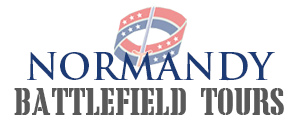DEAD MAN’S CORNER
www.NormandyBattlefields.com/Virtual Tour (click on #10 to enlarge the 1944 aerial photo, points marked)
The “T” junction highway corner had to be taken by the American paratroopers and held for expansion of the beachhead. The German viewpoint was to keep the corner open as their possible escape route. Dead Man’s Corner was a focal point for several days of close hand to hand fighting. Few roads ran north-south entering and exiting the Contentin peninsula. National Highway 13 was the main road of the only three usable roads. Cutting all the roads at the base of the peninsula would eliminate three German divisions’ resupply opportunities and their potential southern retreat route if needed.
To day the Liberty Expressway replaces the bypassed wartime N13 road. Exiting on to the D913 road when driving west, on the expressway, from Bayeux one can go right, 6 miles, to UTAH Beach or left, a half mile, to Dead Man’s Corner. The 101st Airborne paratroops heading to the Corner had landed in the fields to the east of the expressway intersection. The American paras had been scattered creating regrouping delays and causing objective schedules to change.
The Allies air activities, over the area, in the early hours of June 6th gave cause for German Lieutenant Colonel von der Hedyte to move his paratrooper regiment, by bicycle, 14 miles to St Come du Mont a half mile north of the Corner. As reports came in of American airborne landings von der Heydte dispatched his three battalions north, east and south of his headquarters in the St Come church. At dawn he ascended the belfry and viewed the 5600 ship invasion fleet in awe. His thought was, “We are finished”.
During D-Day the two enemies manuvered moving into the hedgerows facing each other across the N13 roadway. Skirmish lines were established. The American objective was to capture the Corner then move southward down the N13 road towards Carentan. As sniping went on between the paras, in the afternoon, American C-47s unknowingly dropped seemingly endless re supplies of ammo, guns, medical supplies, cigarettes and food, behind the German lines. The enemy paras were ecstatic. Real cigarettes (not ground wood chips rolled in leaves). Sanka and Nescafe! Not dry leaves boiled. Carnation Eagle Brand milk to which they added the instant coffee, stirred and drank developing a sugar-caffeine high. Cellophane packaged toilet paper ?? Never had the German army ever supplied that practicality. Their morale tumbled. How could they possibly win against an army so amply and thoroughly supplied by an untouchable manufacturing supply base headquarters 4000 miles away in America ???
June 7th, (D-Day +1), afternoon, Dog Company of the 506th Parachute Infantry Regiment, (that would 11 months later capture Hitler’s mountain home in Bertesgarten, Austria) advanced on the Corner accompanied by a column of light tanks that had landed across UTAH Beach the previous day. From the Douve hamlet, a few hundred yards south, on the N13, the crack of a 57 mm German PAK anti tank gun echoed along the road shoulder hedgerows. The armor piercing missile found its mark on the first tank at the corner as it pased next to the concrete posted steel mesh fence present today. To-days museum building, at that time, was an aid station manned by American and German medics handling the wounded of both sides.
The shell penetrated the tank in the driver’s area, exploded ripping part the crew. The resulting blast of enveloping flames flushed through the open turret incinerating the lieutenant commanding the tank. The battle progressed. The Corner fell and the 506 PIR’s men moved south towards objective Carentan. The Germans withdrew south from Ste Come du Mont along the elevated railroad embankment a few hundred yards west of the N13 road. (This story will be covered in a separate Blog.)
The burned out tank and the officer’s corpse remained at the corner several days before graves registration could remove, identify and designate a temporary cemetery for burial of the four sets of remains. The T-junction had much traffic but no official name so the passing soldiers and vehicles described it, “where the dead man is in the tank turret”. Heavy supply traffic from UTAH Beach and Cherbourg continued to go through the Corner over the following 8 months until the north coast ports of France and Belgium were captured and opened to off load the incoming US shipments. So named “Dead Man’s Corner” is official. It’s name commemorates not just the crew of one tank but the casualties of human lives it cost to gain the insignificant but important “T junction”. A place of honor to “Stand Where They Fought”.


